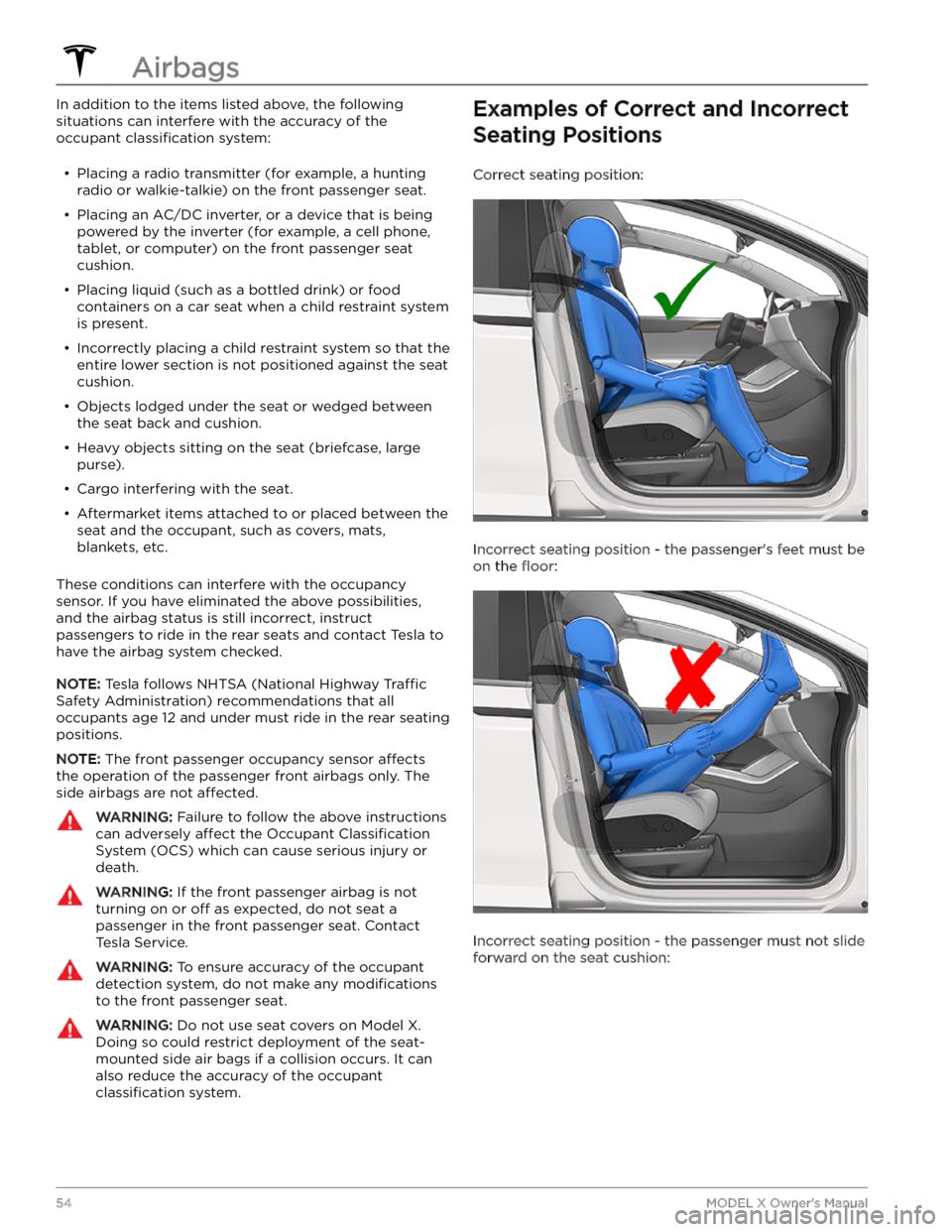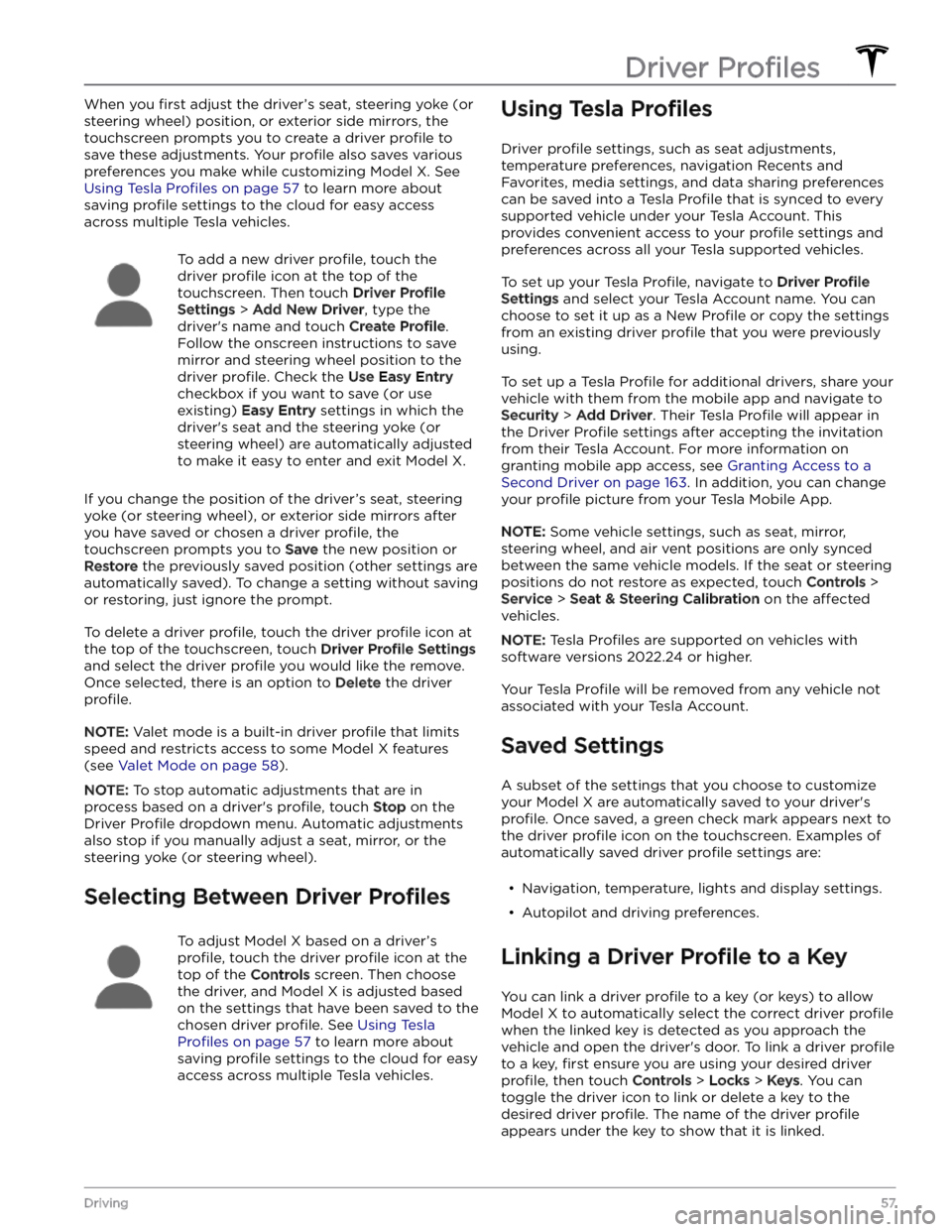TESLA MODEL X 2023 Workshop Manual
MODEL X 2023
TESLA
TESLA
https://www.carmanualsonline.info/img/26/58624/w960_58624-0.png
TESLA MODEL X 2023 Workshop Manual
Trending: trunk, low oil pressure, rear entertainment, horn, ESP, remote start, warning lights
Page 51 of 296

Single Strap - Second Row Bench Seats
Single Strap - Third Row Seats
Testing a Child Safety Seat
Before seating a child, always make sure the child safety seat is not loose:
1.
Hold the child safety seat by the belt path and try to slide the safety seat from side to side and front to back.
2.
If the seat moves more than one inch (2.5 cm), it is
too loose. Tighten the belt or reconnect the
LATCH
retained child safety seat.
3.
If you are unable to reduce slack, try a different seat
location or try another child safety seat.
Child Safety Seat Warnings
WARNING: Extreme hazard! Do not seat a child on
the front passenger seat even if you are using a
child safety seat. This seat has an airbag in front of
it. Although this airbag is disabled when Model X
detects a lightweight passenger, do not rely on
technology to protect your child.
WARNING: Child safety seats are designed to be
secured in vehicle seats by lap belts or the lap belt
portion of a lap-shoulder belt. A child could be
endangered in a crash if a child safety seat is not
properly secured in the vehicle.
WARNING: According to collision statistics,
children are safer when properly restrained in a
rear seating position than in the front passenger
seat.
WARNING: Do not use a forward-facing child
safety seat until your child weighs over 20 lbs (9
kg) and can sit independently. Up to the age of
two, a child
Page 52 of 296
WARNING: To ensure children are safely seated,
follow all instructions provided in this document
and by the manufacturer of the child safety seat.
WARNING: Children should ride in a rear-facing
child safety seat using the seat
Page 53 of 296
Location of Airbags
Airbags are located in the approximate areas shown below. Airbag warning information is printed on the sun visors.
Model X is equipped with an airbag and lap/shoulder belt at both front seating positions. The airbag is a
supplemental restraint at those seating positions. All occupants, including the driver, should always wear their seat belts whether or not an airbag is also provided at their seating position to minimize the risk of severe injury or death
in the event of a crash.
1.
Knee airbags
2.
Front airbags
3.
Curtain airbags
4.
Seat-mounted side airbags
5.
Door-mounted airbags
How Airbags Work
Airbags inflate when sensors detect an impact that
exceeds deployment thresholds. These thresholds are designed to predict the severity of a crash in time for
the airbags to help protect the vehicle
Page 54 of 296
Front airbags are not ordinarily designed to inflate in
rear collisions, rollovers, side collisions and when braking heavily or driving over bumps and potholes. Likewise,
front airbags may not
inflate in all frontal collisions, such
as minor front collisions, underride collisions, or minor
impacts with narrow objects (such as posts or poles).
Significant superficial damage can occur to the vehicle
without the airbags
inflating and, conversely, a relatively
small amount of structural damage can cause airbags to
inflate. Therefore, the external appearance of the vehicle
after a collision does not represent whether or not the front airbags should have
inflated.
WARNING: Before modifying Model X to
accommodate a person with disabilities in a way
that may affect the airbag system, contact Tesla.
Types of Airbags
Model X has the following types of airbags:
Page 55 of 296

Object ClassificationOCS Passenger Airbag
Status*Indicator statusNotesForward facing child restraint
systemOFFPASSENGER AIRBAG OFF35 lbs (16 kg) or lessChild in a booster seatOFF or ONPASSENGER AIRBAG OFF or
PASSENGER AIRBAG ON20-100 lbs (9-45 kg)*Large childOFF or ONPASSENGER AIRBAG OFF or
PASSENGER AIRBAG ON 5th percentile female or larger
(by weight)ONPASSENGER AIRBAG ONOver approximately 100 lbs (45 kg)*If the passenger airbag status indicator does not match the situation, do not use the seat. The passenger must ride in a different seat. Contact Tesla Service.
NOTE: It takes approximately six seconds after you power on Model X for the occupant classification system (OCS)
to report accurate status of the front passenger airbag. As a result, when you
first power on Model X, even in
situations when it should be OFF because the seat is occupied by a weight of
20 lbs (9 kg) or less, it will take the
touchscreen approximately six seconds to display the status, PASS AIRBAG OFF. If it fails to do so, contact Tesla Service and do not seat a child in the front passenger seating position.
To make sure the sensing system can correctly detect occupancy status, eliminate the following:
Page 56 of 296
In addition to the items listed above, the following situations can interfere with the accuracy of the occupant
classification system:
Page 57 of 296
Incorrect seating position - the passenger must not
recline the backrest to a laying down position when the
vehicle is moving:
Inflation Effects
WARNING: When airbags inflate, a fine powder is
released. This powder can irritate the skin and
should be thoroughly flushed from the eyes and
from any cuts or abrasions.
After inflation, the airbags deflate to provide a gradual
cushioning
effect for the occupants and to ensure the
driver
Page 58 of 296
WARNING: Do not use a rear-facing child restraint
system on a seat with an operational airbag in
front of it. Doing so can cause injury or death if the
airbag inflates.
WARNING: To ensure correct inflation of the side
airbags, maintain an unobstructed gap between an
occupant
Page 59 of 296
When you first adjust the driver
Page 60 of 296
NOTE: Model X supports up to 10 driver profiles. You can
link multiple keys to a driver
profile, but you cannot link
multiple driver
profiles to a single key.
Easy Entry
You can define an Easy Entry setting that moves the
steering yoke (or steering wheel) and driver
Trending: dashboard, reset, lights, headlights, cooling, traction control, wiper fluid



















